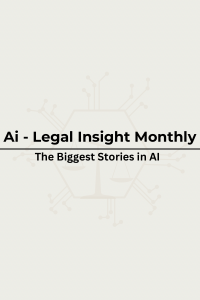Welcome to the AI-Legal Insight Monthly News Roundup! Each month, we bring you the biggest AI and legal developments – tech breakthroughs, regulatory battles, and everything in between.
AI continues to dominate headlines, with February 2025 proving to be a game-changer in governance, investment, and innovation. From landmark regulatory shifts in Europe to massive corporate investments and cutting-edge AI advancements, here are the most important AI stories you need to know. This month has shown that AI is not just a technological trend but a major force shaping global economies and policies. The rapid development has led to both excitement and growing concerns about its implications for society.
Global News
1. The AI Action Summit in Paris: Global AI Governance at a Crossroads
Paris hosted the much-anticipated AI Action Summit, bringing together world leaders, tech executives, and policymakers to discuss AI regulation and its societal impact. While 57 nations signed the Statement on Inclusive and Sustainable AI, tensions surfaced as different countries clashed over AI safety, data privacy, and market control. The divide between highly regulated regions, like the EU, and more innovation-driven areas, such as the US and China, was on full display. Many industry leaders pushed for a balanced approach, arguing that overregulation could stifle AI-driven progress in critical areas like healthcare, automation, and cybersecurity.
A key takeaway? Europe is pushing for stronger regulations to ensure ethical AI use, while the US and China advocate for faster innovation with minimal restrictions. Some countries criticized the vague language of the agreements, while industry leaders warned that excessive red tape could hinder progress. Meanwhile, developing nations expressed concerns that stringent AI regulations might prevent them from accessing the technology needed for economic growth. The summit ultimately highlighted the power struggle over AI governance, revealing deep-seated tensions between technological ambition and regulatory caution.
The summit highlights ongoing struggles to balance AI safety and innovation, setting the stage for potential legal battles over international AI standards. As AI continues to evolve, we can expect further negotiations and adjustments to regulatory frameworks worldwide. The question remains: Can global policymakers keep up with AI’s rapid evolution while ensuring it remains ethical and beneficial for all?
2. OpenAI’s Expansion into Munich: Europe’s AI Hub?
OpenAI made waves by announcing the launch of a new office in Munich, a strategic move aimed at strengthening its European presence. The Munich hub will focus on AI safety research, regulatory compliance, and cutting-edge AI model development. This marks a significant step in OpenAI’s global expansion strategy, reflecting the increasing importance of the European market in AI research and deployment. By setting up operations in Germany, OpenAI is also signaling its willingness to work within Europe’s evolving AI regulatory framework.
Why Munich? Germany’s strict AI policies and its role in the EU AI Act make it an ideal testing ground for OpenAI’s commitment to “safe and responsible AI.” However, some experts speculate this move is also meant to appease European regulators, who have been increasingly scrutinizing Big Tech’s AI ambitions. With the EU pushing for more accountability in AI development, OpenAI’s presence in Germany could serve as a bridge between industry and government, fostering collaboration on responsible AI deployment.
Additionally, Munich’s growing AI talent pool and strong academic institutions make it an attractive hub for AI research and development. This move could also attract AI researchers and startups looking to collaborate with OpenAI, boosting Germany’s position as a key player in global AI innovation. However, some critics argue that this expansion may also be an attempt to secure European market dominance before stricter AI regulations are enforced.
OpenAI’s expansion will likely be closely watched by EU regulators, as AI companies are now required to comply with the newly implemented EU AI Act (more on that below). If OpenAI successfully integrates into the European AI ecosystem while maintaining regulatory compliance, it could set a precedent for how AI companies operate within strict governance structures. The long-term impact of this expansion remains to be seen, but it certainly marks a turning point in the AI industry’s relationship with European regulators.
3. The EU AI Act Takes Effect: The Rules Are Here
The first phase of the EU AI Act officially came into force in February, ushering in one of the most comprehensive AI regulations worldwide. The law bans AI applications deemed too risky, such as emotion recognition in workplaces, while imposing strict transparency and accountability measures on AI developers. This makes the EU the first major global power to enforce binding AI laws, setting a precedent for international AI governance.
Companies operating in Europe must now document AI training data, disclose AI-driven decisions, and ensure their models align with EU ethical standards. While this is a win for consumer rights, many businesses fear compliance costs and legal uncertainties could slow AI innovation in Europe. Tech firms will need to navigate a complex regulatory landscape, ensuring that their AI systems meet compliance requirements without compromising efficiency or competitiveness.
While some see this as a much-needed safeguard against AI risks, others argue that it could push AI innovation away from Europe, favoring more loosely regulated regions. The impact on small and mid-sized AI startups is particularly concerning, as they may struggle to comply with stringent regulatory demands. The question remains: Will this act set a global standard or create barriers that drive AI development elsewhere?
The Act establishes precedents for global AI regulation, likely influencing other regions to follow suit or adopt competing frameworks. Companies must now develop AI compliance strategies, and legal challenges are expected as firms navigate the gray areas of implementation. The full impact of the law will unfold over the next few years, shaping how AI is developed and used worldwide.
4. Nvidia’s AI Weather Forecasting: A Climate Game-Changer
Nvidia introduced NVIDIA CorrDiff, an AI-powered weather forecasting model capable of making hyper-accurate short-term predictions. Using deep learning and neural networks, it surpasses traditional forecasting methods, reducing error margins by up to 40%. This advancement could help mitigate the impact of natural disasters by providing more precise warnings for extreme weather conditions. Governments and industries reliant on weather forecasting, such as agriculture and transportation, are closely monitoring Nvidia’s developments.
By integrating AI into meteorology, Nvidia is challenging traditional forecasting institutions that rely on physics-based modeling. Some critics worry about over-reliance on AI-driven weather predictions, warning that machine-learning models may struggle with extreme, unpredictable climate events. Despite this, Nvidia’s advancements represent a significant leap in how we predict and respond to climate-related challenges.
This is one of AI’s most practical applications yet, with immediate benefits for millions worldwide. As climate change intensifies, tools like Nvidia CorrDiff could play a vital role in disaster prevention and mitigation.
5. Grok-3: Elon Musk’s AI Challenger
Elon Musk’s xAI unveiled Grok-3, a new AI model designed to compete with OpenAI’s GPT-4 and Google’s Gemini AI. Unlike its competitors, Grok-3 is designed to be open-source, allowing greater transparency and community-driven improvements. Musk has emphasized that Grok-3 is built to avoid excessive content moderation, offering users a model that is “more free-thinking” than its rivals.
While this has excited free speech advocates, it has also raised concerns about AI-generated misinformation and regulatory oversight. Many fear that a less-restricted AI model could be exploited to spread harmful content or disinformation. Grok-3’s open-source nature also makes it harder for regulators to track and control misuse, presenting new challenges for global AI governance.
If Grok-3 gains traction, regulators may be forced to revisit AI content moderation policies, especially in the context of upcoming elections worldwide. Musk’s move signals a pushback against the increasing control of AI-generated content, but it also puts xAI in direct conflict with regulatory bodies concerned with online safety and misinformation.
6. Google’s Vision for AI: The Future of Innovation
At the AI Action Summit, Google CEO Sundar Pichai laid out Google’s roadmap for AI, calling it the „next industrial revolution.“ Google is investing heavily in AI-driven medical research, climate solutions, and AI-assisted coding tools, ensuring it remains ahead of the competition. Pichai emphasized the company’s commitment to making AI more accessible, particularly for businesses, researchers, and non-profits. By offering AI tools with user-friendly interfaces and seamless integration into existing workflows, Google aims to democratize AI development.
One of the most significant revelations was Google’s plan to expand Gemini AI, their flagship large language model, into healthcare and sustainability sectors. By leveraging AI for drug discovery, personalized medicine, and environmental conservation, Google is pushing AI beyond conventional applications. While this sounds promising, critics argue that Google’s AI expansion is primarily profit-driven, raising ethical concerns about data privacy and the control of AI-driven medical and environmental insights.
Additionally, Google announced an expansion of AI-powered search enhancements, promising a more intuitive and personalized browsing experience. However, with the rise of AI-generated search results, concerns about accuracy, bias, and content prioritization remain. Many fear that AI-curated information could deepen filter bubbles and impact users‘ access to diverse perspectives.
Expect antitrust scrutiny as Google expands its AI empire, with regulators watching closely. The increasing reliance on Google’s AI tools in critical fields like healthcare and climate science could trigger debates about corporate influence and AI governance.
7. Apple’s $500 Billion AI Investment: The Future is Now
Apple stunned the tech world with its announcement of a $500 billion AI investment, focusing on AI-driven hardware, cloud computing, and AI-powered personal assistants. A key component of this plan includes a Texas-based AI server factory, signaling Apple’s ambition to rival cloud giants like Amazon and Microsoft. This is Apple’s largest-ever investment in AI, demonstrating how serious the company is about securing a dominant role in the AI revolution.
This move isn’t just about AI—Apple is positioning itself for dominance in AI-integrated devices, ensuring the next generation of iPhones, Macs, and wearables will be AI-powered from the ground up. Apple’s long-term vision includes on-device AI models capable of functioning independently from the cloud, enhancing user privacy and speed. This aligns with Apple’s brand image of prioritizing user security while delivering cutting-edge innovation.
The investment also reflects Apple’s growing focus on AI-driven automation in software development, supply chain management, and customer service. However, this level of spending has raised concerns about potential monopolization, with some experts questioning whether Apple’s AI ecosystem will become too closed off, limiting competition. Smaller AI firms worry that Apple’s dominance could stifle innovation, making it harder for new players to enter the market.
With Big Tech monopolization concerns growing, this level of investment could attract regulatory scrutiny, especially from the EU and US authorities. As Apple builds out its AI infrastructure, it will need to navigate antitrust regulations, ensuring fair competition while continuing its aggressive push into AI. The coming years will reveal whether Apple’s strategy cements its leadership or faces roadblocks from regulators.
Stay curious, stay informed, and let´s keep exploring the fascinating world of AI together.
This post was written with the help of different AI tools.
Lorem ipsum dolor sit amet, consectetur adipiscing elit. Ut elit tellus, luctus nec ullamcorper mattis, pulvinar dapibus leo.
Lorem ipsum dolor sit amet, consectetur adipiscing elit. Ut elit tellus, luctus nec ullamcorper mattis, pulvinar dapibus leo.




